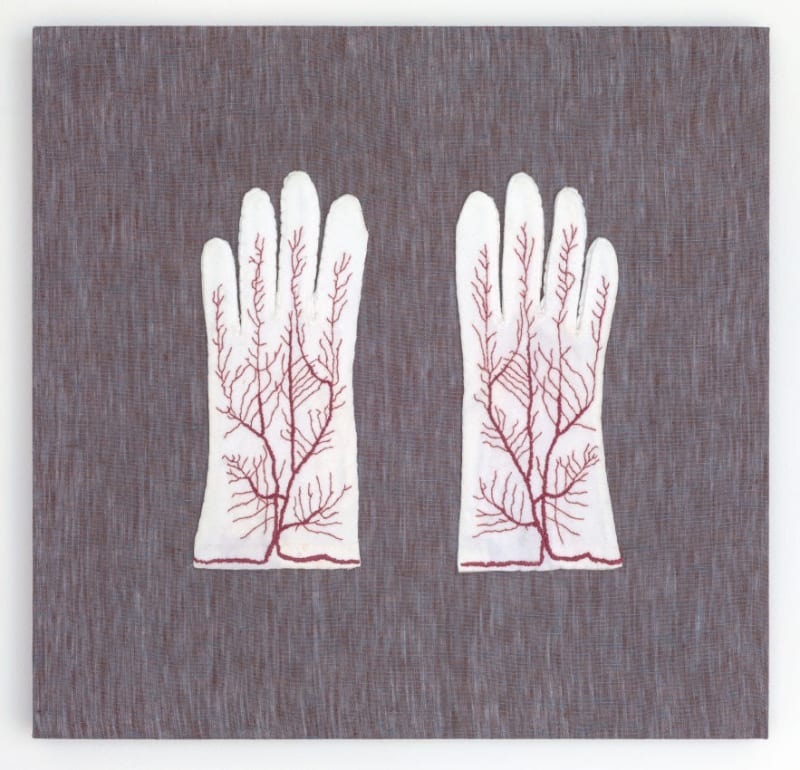“Later on, I could perform a more sophisticated maneuver by doubling back on and reversing the injunction against AbEx, performing a critique of the critique, one that allowed me to appropriate AbEx as a practice back into my own hands and twist it into the form I wanted it to assume.” This line from Amy Sillman’s fabulous essay “Ab-Ex and Disco Balls: In Defense of Abstract Expressionism II” published in these pages in 2011—came to mind as I viewed Elaine Reichek’s second solo show at Marinaro, “Material Girl,” where she turned her gimlet eye onto the long interlaced history connecting painting, abstraction, and textiles.
Hugging a corner and an adjacent wall of the gallery, respectively, were JP Textile/Text 1 and 2, both 2021. At first glance, they appeared to be found objects, comprising long swaths of mottled fabric stretched out from wall-mounted metal dispensers. Yet after a bit more time with these works, I saw that Reichek was poking fun at Jackson Pollock’s overcooked legacy (and at Harold Rosenberg’s designation of lazy AbEx as “apocalyptic wallpaper”). Each piece showcases a length of Kravet Inc.’s Spatter fabric—a commercially printed textile with an allover Jack-the-Dripper effluence—onto which Reichek digitally stitched twenty-five citations pulled from the artist’s capacious bibliography. From Jackson Pollock, Frank O’Hara’s 1959 book on the painter, to a 2017 volume of the Artist Series from New York’s Museum of Modern Art, each reference was given its own distinct font and placed within the composition—in a curved or sloped line, in a circle, or crisscrossed with another text—at least three times over the length of the fabric. Using two versions of Spatter, Reichek mimicked the textile’s colorways with several similarly hued threads. Consequently, Pollock’s critical, commercial, and mainstream successes were brought down a peg by Reichek’s complicated and clever brand of shade—a “twisting” à la Sillman.
On a nearby wall, twenty-six variously sized digitally and hand-sewn embroideries were hung salon style. The installation seemed like a compendium of works by artists who have depicted fashion, interior design, and other forms of angewandte kunst across the centuries—from Albrecht Dürer’s renderings of pillows and a Michelangelo drapery study to Edgar Degas’s bows and Eugène Delacroix’s Algerian robes, to Varvara Stepanova’s sportswear and, my personal favorite, Jean-Antoine Watteau’s depiction of a faceless Pierrot. Also on view were borrowings from Bronzino, John Currin, Artemisia Gentileschi, Kerry James Marshall, Wayne Thiebaud, and Édouard Vuillard, among many others. It was amusing to guess which work had been made manually by Reichek and which had not (hint: The more densely threaded pieces were digital), and then to realize that each piece essentially brought painting back to its grounds, i.e., to canvas, to fabric.
A few more works containing excerpts from writings by Tracy Chevalier, Susan Howe, and Barbara Pym recalled Reichek’s last solo outing at this gallery, “Sight Unseen,” which featured embroideries that borrowed lines from stories, plays, and poems. (Remember that the words text and textile both come from the Latin texere, to weave.) Turkey-Work (Susan Howe), 2020, for example, quoted the titular poet’s lines on “one of the most misunderstood materials in decorative art studies,” a form of needlework that has roots in sixteenth-century England—a bastardization of the weaving technique used to make Turkish carpets. Suitably, a bright-red turkey-work frame surrounds the textile.
In a second room, Reichek staged a tongue-in-cheek homage to Henri Matisse: Set onto a commercially made carpet with organic patterns based on the painter’s cutouts were examples of the types of parlor furniture Matisse owned alongside several potted Monstera plants (whose forms inspired the artist to create the cutouts) and a double-sided green velvet folding screen. Images of these partitions can be found throughout his oeuvre, and onto hers Reichek affixed an assortment of ready-made Matissean products, with pictures of his studios and source imagery, emphasizing his colonialist and sexist gaze. Beautifully researched, the installation also included a grid of swatches reproducing Matisse’s Blue Nude II, 1952, and brightly hued, hand-embroidered reproductions of his notes for three of his tapestry works. Imitation is the sincerest form of flattery, yet Reichek’s work is not mediocre by any stretch of the imagination, as few artists have deconstructed and dismantled the myth of the modernist male “genius” as tartly as she has.

